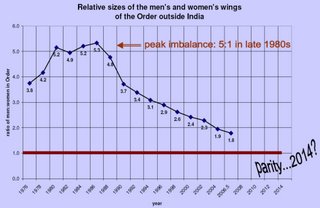The Western Buddhist Order at 40 part III: Men and women in the Order
 Continuing this week’s theme of celebrating the 40th anniversary of the Western Buddhist Order by looking at some of its features and characteristics, today focuses on the balance between men and women in the Order. Today there are just over 500 women Order Members, or Dharmacharinis, and just under 1,000 men, or Dharmacharis, a ratio of .just under 1:2, or 1:1.8 outside India, where men still predominate - though even there there are now 57 Dhammacharinis.
Continuing this week’s theme of celebrating the 40th anniversary of the Western Buddhist Order by looking at some of its features and characteristics, today focuses on the balance between men and women in the Order. Today there are just over 500 women Order Members, or Dharmacharinis, and just under 1,000 men, or Dharmacharis, a ratio of .just under 1:2, or 1:1.8 outside India, where men still predominate - though even there there are now 57 Dhammacharinis.The chart shows how this gender ratio has shifted over the past 30 years – and it demonstrates very strikingly how it has moved towards parity every year without fail for the last 20 years – from a very imbalanced state of over 1:5 women:men in 1987.
This ratio looks set to equalise further over the coming years – one ingredient that will likely help ensure this is the fact that among the Preceptors (senior members of the Order authorised to conduct ordinations), there are currently 51 women compared to 71 men, a significantly higher proportion that would be expected simply from the relative sizes of the two ‘wings’ of the Order. Among the Chairmen and Chairwomen of the main FWBO centres worldwide, however, there are approximately 35 men and 20 women Chairs - this time showing an almost exactly proportionate number of women taking leading roles.
The Western Buddhist Order has always been unusual amongst Buddhist sanghas in that it has from its inception insisted upon a single and equal ordination for men and women - who are themselves ordained by members of their own gender – a practice whose implications have been fascinatingly analysed in ‘Androgyny Among Friends’ by Professor Richard Hayes, himself a member of the Order, in an essay written to provide an alternative theoretical framework to the one articulated by Rita Gross in her well-known Buddhism After Patriarchy.
Also likely to assist the continuing move towards parity, last year a new FWBO women’s retreat centre opened in Spain, dedicated to providing ideal conditions for women embarking on their long ordination retreats. Akasavana, the new centre, joins Tiratanaloka, dedicated to training women for ordination, and Taraloka, our ‘general’ retreat centre for women.

 rss
rss
2 Comments:
OK, so the WBO has an equal Ordination for men and women.
But this needs to be seen in the context of the fact that Sangharakshita, WHO IS STILL VERY MUCH AN INFLUENCE WITHIN THE WBO, has made it more than clear that he considers women, generally speaking, to be at a spiritual disadvantage compared to men.
Many women have found this position deeply discouraging, and it no doubt contributed to the low numbers of women Order Members in the early days of the WBO.
This ideology about women in practice seriously undermines the idea of an 'equal' Ordination, and I think that as a matter almost of honesty it needs to be mentioned when the WBO is talking about its 'equal' Ordination for men and for women.
Hi jr,
Your point is undermined by the acceleration of the numbers of women currently entering the order over the last 20 years - far more women than men have been being ordained for some years now. Women clearly find the FWBO a community in which they can practice, and one which they are happy to make a substantial commitment to.
Of course Bhante is very much an influence on the movement - how could it be otherwise? He is our founder and our system of practice was designed by him. Bhante has said that generally speaking at the beginning of the spiritual life women may be at a disadvantage to men because, largely of the desire to have children, but that they have the same spiritual potential as men. He does not say that he believes women are universally at a disadvantage, nor that they are always at a disadvantage. So much for what Bhante says. However in the FWBO there is always a diversity of opinion on most points and, on the whole, I most of us would now disagree with Bhante's views on women and would not endorse the view. I think the main thing to point to here is the many amazing women practitioners in our movement, and the many outside the FWBO as well.
One of the strengths of a distributed, non-hierachical movement means that, unlike many other Buddhist movements which maintain feudal attitudes to authority, we are free to disagree with Sangharakshita. We are not bound to accept everything Bhante says, but like the Kalamas test teachings against our own experience.
Post a Comment
<< Home